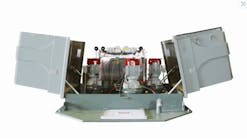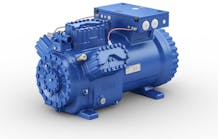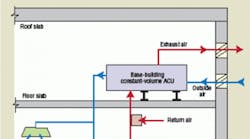Building improvements are straightforward when the owner of a facility also is the occupant. The same cannot be said when, as in the case of many high-rise office buildings, the owner simply is the landlord, with dozens of tenants and spaces in various states and stages of occupancy. When it comes to energy, the tendency is for owners of these structures to charge tenants for all consumption and make no improvements. This is unfortunate, as opportunities for energy conservation—and, thus, carbon-dioxide (CO2) reduction—through the regulation of ventilation air abound, bringing with them money-saving and public-relations benefits for both owners and tenants.
This article discusses how owner-controlled base-building improvements and tenant-controlled space improvements can save energy in a high-rise office building without negatively impacting one another or violating terms of lease agreements. Specifically, it discusses a process of transitioning from constant-volume to variable-air-volume (VAV) control with the intent of reducing overall energy consumption and CO2 emissions and earning recognition through certification programs such as the U.S. Green Building Council's Leadership in Energy and Environmental Design (LEED) for Existing Buildings: Operations & Maintenance (O&M) and LEED for Commercial Interiors (LEED-CI).
BARRIERS
The prevailing lease-defined owner/tenant relationship is not conducive to cooperative energy reduction. For example, HVAC use typically is not metered; tenants pay a fixed monthly rate as part of their lease. Any fluctuation in the rate from year to year is the result of external utility rates, not—directly at least—tenant consumption. Thus, if a tenant installs occupancy sensors to reduce airflow to unused portions of a space, the owner benefits, saving base-building fan energy, while the tenant does not, continuing to pay the same monthly rate.
In cases in which energy use is sub-metered, a tenant may choose to install free-cooling coils in supplemental air-conditioning units (ACUs) in an attempt to reduce power consumption. But if the owner reduces base-building cooling-tower-fan speed amid low-ambient-temperature conditions, the tenant might never receive water cool enough for the free-cooling coils to be used. The owner, then, saves through reduced cooling-tower-fan energy, while the tenant does not.
When base-building and tenant systems operate independently, simultaneous heating and cooling is possible. Although some tenant systems, such as water-leakage detection, are monitored by base-building building-management systems, few base-building-supplied heating/cooling media are reset based on tenant needs.
Even when both an owner and a tenant desire green-building certification, each may be reluctant to take the first step and gamble on the other's follow-through. Following is a discussion of how owners and tenants can work together to upgrade a building.
THE PROCESS
Consider an older building with a constant-volume base-building air-supply system and constant-volume tenant systems on each floor (Figure 1).
Step 1
If they are not already in place, the owner unilaterally installs heat-recovery and/or economizer systems for the base-building ventilation system. Retrofitting heat recovery requires that outside-air intake and ventilation exhaust occur at the same place in a building. Economizer cycles can be based on ventilation air or water-side free cooling from cooling towers.
Step 2
Even if all tenant floors have constant-volume systems, the owner installs a VAV base-building air-supply system. Although owners typically think this will not save money because the tenant systems and, thus, the base-building system never will reduce air volume, the opposite is true, even if no tenant has a VAV system in place.
Figure 1 shows a building with one or more air-riser shafts and multiple floors supplied with tempered air from one or more constant-volume base-building ACUs. Each floor has a constant-volume system. In Figure 2, the ACU (or, in newer buildings, perhaps an air-handling unit [AHU]) is equipped with economizer and/or heat-recovery systems, and the owner saves energy. Such a retrofit will be difficult if the building is equipped with older floor-by-floor ACUs; it will be easy if the owner is replacing the ACUs anyway as part of a larger upgrade. The replacement of an ACU or its controls is a good time to provide a variable-speed drive for supply/return fans, a pressure sensor in air-supply risers, and floor isolation dampers.
This completes the conversion to VAV operation for the base-building side. Although tenant VAV improvements will follow, the owner will save money immediately, even if the tenants do not reduce air volume during occupied hours. Once the base-building ventilation system is converted to VAV operation, the owner can selectively shut off air to unoccupied floors.
Step 3
The owner mandates that all future tenant systems be VAV (Figure 3). This saves increasing amounts of money for the owner by reducing base-building fan energy. Savings for the tenant are not as easy to define, particularly if HVAC charges are bundled into the tenant's lease at a fixed rate. If a space is VAV, an astute tenant will negotiate a lower HVAC charge. To protect its interests during the lease-negotiation process, a tenant may want to enlist the help of the engineering firm involved in designing the fit-out.
Step 4
After base-building savings are optimized, the tenant installs demand-controlled ventilation (DCV). With DCV, a floor's outside-air requirement is reset based on actual occupancy, as determined from carbon-dioxide measurements. (See "Multiparameter Demand-Controlled Ventilation") Figure 4 shows occupancy sensors controlling VAV boxes, shutting off ventilation air to unoccupied spaces. This arrangement is feasible only when each floor was built or retrofitted with an ACU/AHU. If that is the case, tenants have control of outside air for their floors and can (in theory) save by limiting that outside air and reducing supply-fan volume through conventional VAV operation.
Tenants will not see savings if their HVAC charges are bundled into their lease agreement at a fixed cost. They must negotiate a lease whereby the energy consumption of their ACU is sub-metered. Although this kind of lease negotiation is rare, it is imperative if tenants are to be rewarded for employing sophisticated energy management.
LEED BENEFITS
An important benefit of energy conservation is certification of a building under LEED for Existing Buildings: O&M and certification of individual tenant spaces under LEED-CI. Decreasing energy use increases the Energy Star rating of a facility and earns up to 18 points under LEED for Existing Buildings: O&M Energy & Atmosphere (EA) Credit 1, Optimize Energy Efficiency Performance. As tenants install CO2 sensors, a building starts moving toward earning a point under LEED for Existing Buildings: O&M Indoor Environmental Quality Credit 1.2, IAQ Best Management Practices: Outdoor Air Delivery Monitoring. When tenants install submetering for their individual AHUs (Step 4), the owner is on the way toward receiving points under LEED for Existing Buildings: O&M EA Credit 3.2 and 3.3, Performance Measurement: System-Level Metering. When 75 percent of a building's floor area is occupied by tenants who have achieved LEED-CI certification, the building automatically gains four points under LEED for Existing Buildings: O&M Sustainable Sites Credit 1, LEED Certified Design and Construction. Thus, it is advantageous to an owner to negotiate a fair lease agreement with any tenant who wishes to sub-meter and be charged for energy accordingly.
For a tenant wanting to obtain LEED-CI certification, LEED 2009 has increased the number of points attributable to energy efficiency, zoning, and modulating to 10 points. Installing sub-metering equipment, tenant payment of energy and energy use, and measurement and payment accountability earn a total of 10 additional points. Those 20 points put a tenant halfway to the 40-point minimum required for LEED-CI certification. When a building meets LEED for Existing Buildings: O&M certification, tenants automatically gain five points toward LEED-CI certification.
DO NOT FORGET
Commissioning facilities reduces energy consumption while improving comfort, health, and safety. LEED for Existing Buildings: O&M EA Credit 2.1, Existing Building Commissioning: Investigation and Analysis; EA Credit 2.2, Existing Building Commissioning: Implementation; and EA Credit 2.3, Existing Building Commissioning: Ongoing Commissioning, offer a total of six points for commissioning, with a bonus point available in most regions. EA Credit 2.1 is used for energy audits or commissioning plans to help guide energy options for long-term capital plans. EA Credit 2.2 is earned automatically as low-cost/no-cost energy-saving ideas are implemented. EA Credit 2.3 requires only the creation of a long-term recommissioning plan and the completion of half of the work in that plan. Continuous recommissioning can be made part and parcel of a capital plan through updated cost estimates and energy savings.
For tenants seeking LEED-CI certification, fundamental commissioning of building energy systems is a prerequisite in the EA category, while five points are available through EA Credit 2, Enhanced Commissioning.
SIDEBAR: System Differences
This article uses the American Society of Heating, Refrigerating and Air-Conditioning Engineers “single-duct” variable-air-volume (VAV) system as an example. This is the most frequently encountered form of VAV. It consists of a single air-handling unit (AHU) with a variable-speed fan (or, in older systems, variable inlet guide vanes on fans) conveying air to a number of cooling-only VAV terminal units (“boxes”), each of which serves a zone. Each zone consists of one or more spaces with similar load characteristics. The AHU fan reduces speed and air volume as the spaces it serves require less air, thus saving fan and cooling energy. In some cases, supply-air temperature is reset to deliver the warmest air that can provide the required cooling for the worst-case zone. The box controlling the zone is controlled through the building-management system (BMS) with a wall-mounted thermostat (temperature sensor); it additionally can be controlled with a carbon-dioxide sensor or an occupancy sensor in conjunction with the thermostat. This form of VAV is popular in high-rise buildings because interior spaces frequently are in cooling mode during winter as well as summer.
A “bypass” VAV system also provides variable airflow to spaces. Instead of a variable-speed fan, a bypass duct is used to return air to a constant-speed fan, “short-circuiting” the air before it gets to spaces. Such a system offers limited savings, as fan speed and volume stay the same. The system, however, does save some energy, as bypass air increases and fan-pressure decreases. This design is used only in the smallest of systems and has been almost entirely replaced by single-duct VAV.
VAV systems can be equipped with either passive (damper-only) boxes or “fan-powered” boxes. A fan-powered box includes its own small fan to ensure local air movement and enhanced heat transfer across a heating/cooling coil. First, operating and maintenance costs are factors often precluding the use of fan-powered boxes. However, their use in perimeter applications, especially the glass-curtain walls common in high-rise buildings, can eliminate the need for baseboard or cabinet perimeter heat. This allows neat, flush floor space right up to windows and makes energy-wasting simultaneous heating and cooling easy to lock out.
When a single-duct VAV system is duplicated with both a warm-air duct and a cool-air duct, a “dual-duct” VAV system results. Dual-duct systems can be used to provide warmer air to perimeters of glass-curtain-wall high-rise structures during winter while cool winter air is used to cool interior spaces. The system has the potential to be a great energy saver, but the added cost of a duplicate AHU air path, ductwork, terminal units, etc. usually precludes its selection.
A commissioning project manager for AKF Group LLC and a longtime member of HPAC Engineering's Editorial Advisory Board, Ron Wilkinson, PE, LEED AP, is the author of the first commissioning training program for the Leadership in Energy and Environmental Design for New Construction and Major Renovations Green Building Rating System, the chair of the recently formed commissioning advisory committee of The American Institute of Architects (AIA) Committee on the Environment, and the recording secretary for American Society of Heating, Refrigerating and Air-Conditioning Engineers (ASHRAE) Guideline Project Committee 0.2/1.2, The Commissioning Process for Existing Building Systems and Assemblies/The Commissioning Process for Existing HVAC&R Systems. An ASHRAE Distinguished Lecturer and an AIA Continuing Education Lecturer, he has spoken on commissioning practices internationally.









